商标名称的翻译和策略 论文
- 格式:wps
- 大小:283.79 KB
- 文档页数:8
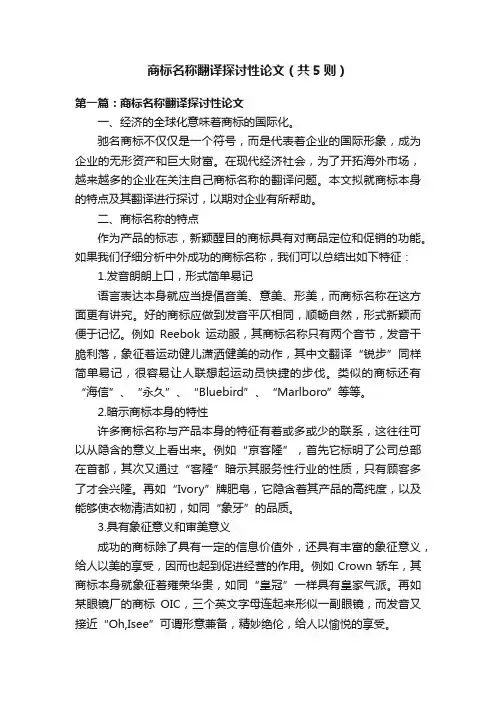
商标名称翻译探讨性论文(共5则)第一篇:商标名称翻译探讨性论文一、经济的全球化意味着商标的国际化。
驰名商标不仅仅是一个符号,而是代表着企业的国际形象,成为企业的无形资产和巨大财富。
在现代经济社会,为了开拓海外市场,越来越多的企业在关注自己商标名称的翻译问题。
本文拟就商标本身的特点及其翻译进行探讨,以期对企业有所帮助。
二、商标名称的特点作为产品的标志,新颖醒目的商标具有对商品定位和促销的功能。
如果我们仔细分析中外成功的商标名称,我们可以总结出如下特征:1.发音朗朗上口,形式简单易记语言表达本身就应当提倡音美、意美、形美,而商标名称在这方面更有讲究。
好的商标应做到发音平仄相同,顺畅自然,形式新颖而便于记忆。
例如Reebok运动服,其商标名称只有两个音节,发音干脆利落,象征着运动健儿潇洒健美的动作,其中文翻译“锐步”同样简单易记,很容易让人联想起运动员快捷的步伐。
类似的商标还有“海信”、“永久”、“Bluebird”、“Marlboro”等等。
2.暗示商标本身的特性许多商标名称与产品本身的特征有着或多或少的联系,这往往可以从隐含的意义上看出来。
例如“京客隆”,首先它标明了公司总部在首都,其次又通过“客隆”暗示其服务性行业的性质,只有顾客多了才会兴隆。
再如“Ivory”牌肥皂,它隐含着其产品的高纯度,以及能够使衣物清洁如初,如同“象牙”的品质。
3.具有象征意义和审美意义成功的商标除了具有一定的信息价值外,还具有丰富的象征意义,给人以美的享受,因而也起到促进经营的作用。
例如Crown轿车,其商标本身就象征着雍荣华贵,如同“皇冠”一样具有皇家气派。
再如某眼镜厂的商标OIC,三个英文字母连起来形似一副眼镜,而发音又接近“Oh,Isee”可谓形意兼备,精妙绝伦,给人以愉悦的享受。
三、商标翻译的常用方法商标名称的翻译并非语言符号之间的简单转换,而是要反映商标本身“短小精悍”的特征,翻译中要兼顾语言文化差异、符合目标客户的审美心理,实现既定的品牌功能。
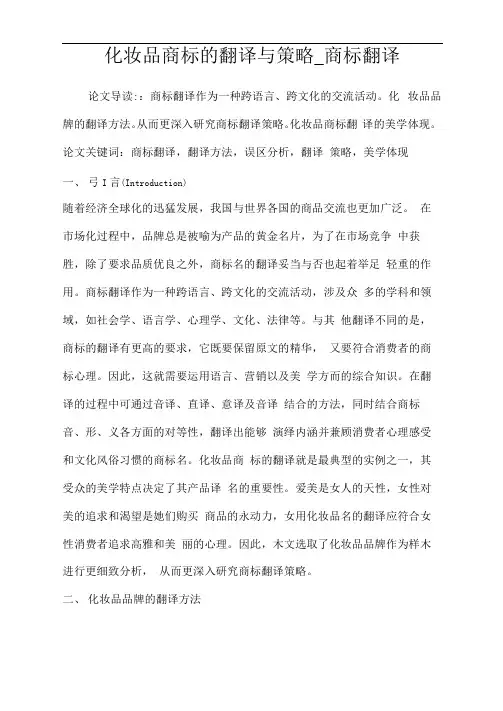
化妆品商标的翻译与策略_商标翻译论文导读::商标翻译作为一种跨语言、跨文化的交流活动。
化妆品品牌的翻译方法。
从而更深入研究商标翻译策略。
化妆品商标翻译的美学体现。
论文关键词:商标翻译,翻译方法,误区分析,翻译策略,美学体现一、弓I言(Introduction)随着经济全球化的迅猛发展,我国与世界各国的商品交流也更加广泛。
在市场化过程中,品牌总是被喻为产品的黄金名片,为了在市场竞争中获胜,除了要求品质优良之外,商标名的翻译妥当与否也起着举足轻重的作用。
商标翻译作为一种跨语言、跨文化的交流活动,涉及众多的学科和领域,如社会学、语言学、心理学、文化、法律等。
与其他翻译不同的是,商标的翻译有更高的要求,它既要保留原文的精华,又要符合消费者的商标心理。
因此,这就需要运用语言、营销以及美学方而的综合知识。
在翻译的过程中可通过音译、直译、意译及音译结合的方法,同时结合商标音、形、义各方面的对等性,翻译出能够演绎内涵并兼顾消费者心理感受和文化风俗习惯的商标名。
化妆品商标的翻译就是最典型的实例之一,其受众的美学特点决定了其产品译名的重要性。
爱美是女人的天性,女性对美的追求和渴望是她们购买商品的永动力,女用化妆品名的翻译应符合女性消费者追求高雅和美丽的心理。
因此,木文选取了化妆品品牌作为样木进行更细致分析,从而更深入研究商标翻译策略。
二、化妆品品牌的翻译方法笔者通过从超市实地调研、参考《昕薇》杂志(20010年20月号)所刊登的化妆品广告、及化妆品相关网页中收集到化妆品畅销品牌共50个商标翻译,通过这些品牌的翻译分析可以看出,我国化妆品品牌翻译主要采用了以下几种译法。
(一)音译法(transliteration)1、汉语拼音法原名译名品名产地DABAO护肤品广州大宝隆力奇LONGLIQI护手霜江苏丹姿DANZI防晒霜YUMEIJING儿童霜天津2、不完全拼音法润发精华素郁美净原名译名品名产地NIVEA 洁而乳上海GARNIER 洁而乳苏州PANTENE 妮维雅卡尼尔潘婷旁氏POND'S洁而乳合肥(二)直译法(literal translation)原名译名品名产地蜂花BEE&F LOWER护发素上海小护士MININURSE护手霜深圳李医生DOCTORLI洗而奶(三)意译法(freetranslation)原名译名品名产地雅倩ARCHE护肤品广东飘柔REJOICE洗发露广东佳雪CATHY防晒霜广东雅芳AVON柔肤水力士LUX洗发乳上海(四)音译结合法(transliteration and free tra nslatio n)原名译名品名产地舒蕾SLEK洗发露武汉舒肤佳Safeguard沐浴露广州可伶可Clea n&Cleer洁而乳上海经过对样品品牌的译法统计,笔者得到以下的数据:译法出现次数所占百分比音译2142%直译714%意译1326%音译结918%样木总50100%从上表的数据分析可以看翻译出,音译占比例的42%,而其他的翻译方法占比例较小。
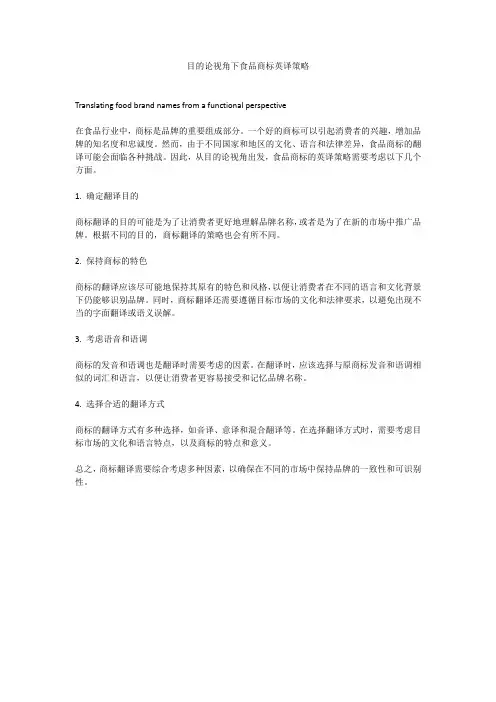
目的论视角下食品商标英译策略
Translating food brand names from a functional perspective
在食品行业中,商标是品牌的重要组成部分。
一个好的商标可以引起消费者的兴趣,增加品牌的知名度和忠诚度。
然而,由于不同国家和地区的文化、语言和法律差异,食品商标的翻译可能会面临各种挑战。
因此,从目的论视角出发,食品商标的英译策略需要考虑以下几个方面。
1. 确定翻译目的
商标翻译的目的可能是为了让消费者更好地理解品牌名称,或者是为了在新的市场中推广品牌。
根据不同的目的,商标翻译的策略也会有所不同。
2. 保持商标的特色
商标的翻译应该尽可能地保持其原有的特色和风格,以便让消费者在不同的语言和文化背景下仍能够识别品牌。
同时,商标翻译还需要遵循目标市场的文化和法律要求,以避免出现不当的字面翻译或语义误解。
3. 考虑语音和语调
商标的发音和语调也是翻译时需要考虑的因素。
在翻译时,应该选择与原商标发音和语调相似的词汇和语言,以便让消费者更容易接受和记忆品牌名称。
4. 选择合适的翻译方式
商标的翻译方式有多种选择,如音译、意译和混合翻译等。
在选择翻译方式时,需要考虑目标市场的文化和语言特点,以及商标的特点和意义。
总之,商标翻译需要综合考虑多种因素,以确保在不同的市场中保持品牌的一致性和可识别性。
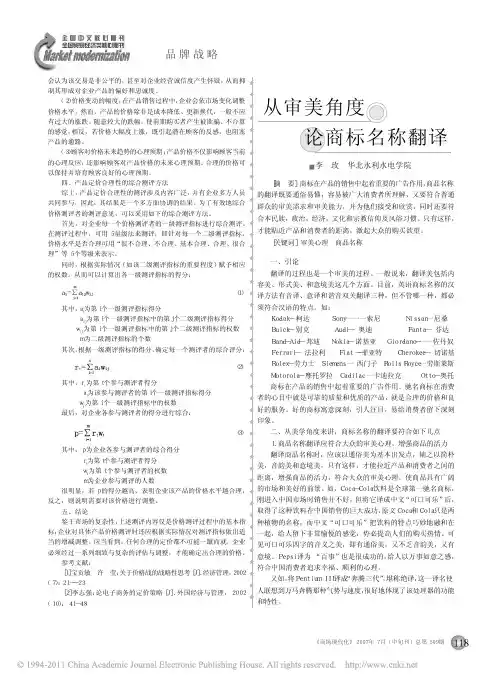
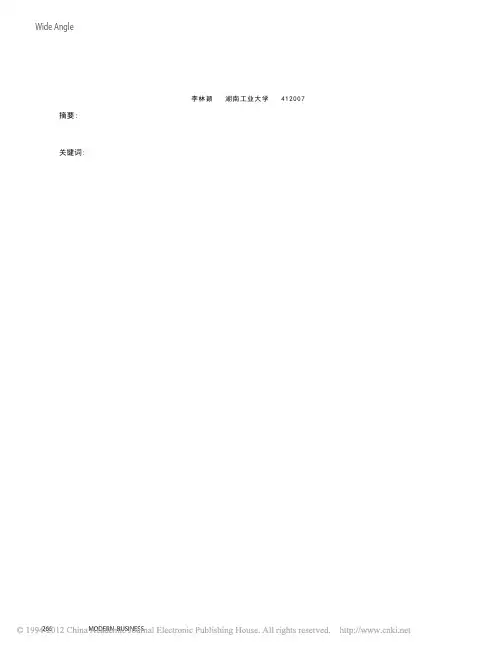
Wide Angle | 广角MODERN BUSINESS现代商业266中英文商标名称的互译李林颖 湖南工业大学 412007摘要:品牌名称的翻译是跨文化交流的一种形式。
然而,我们把中文商标翻译成英文或把英文商标翻成中文,将会涉及到语言、法律、文化心理、审美情趣和其他一些因素。
翻译者也应注意一些文化禁忌并选择适当的方法来翻译。
当然,品牌翻译不是一件简单的事情。
我们翻译商品名称时,尽可能做到力求完美。
一个好的商品添加一个好名字它的魅力是无穷的。
关键词:中英文商标; 文化; 译法; 禁忌国内国际商业经营中,各类商品都有商标,注册后的商标成为某种产品的专有名字。
人类进入21世纪,国际贸易发展迅速。
当商业合作和进出口规模不断扩大时,国家的边界逐渐淡化。
除了广告媒介,进口和出口的产品是否可以在国外的土地上成功开发市场,品牌名称的翻译正扮演着关键的角色。
商品品牌的名称类似人的名字。
翻译的品牌名称是商品在其他国家的第二名字,其重要性不言而喻。
一、品牌名称的翻译原则一个成功的翻译品牌既要保留原有文字的本质,还要具有与原文相同的影响力,在必须符合消费者名牌心理的同时,还要注意到英语和汉语的文化差异。
(一)品牌名称翻译的广告性质原则翻译后的品牌名称必须确定产品的性质和特点,体现原有的本土化概念,在原文的基础上,起着广泛传播的作用。
同时,译后名称必须符合商品的特性,简洁新颖,发音甜美。
有利于拼、读、写和记忆,并容易使消费者理解,并对商品产生好的印象。
例如,“Dynasty”——英文商标是“皇朝葡萄酒”,让我们不禁联想其古老而神秘的东方国家,因此,我们对良好的陈酒产生好的印象。
“Forever”是“永久自行车”的商标,它符合自行车完美的“经久耐用,直到永远”的广告。
“飞鸽自行车”翻译成“Flying Pigeon”,鸽子是和平的象征,“flying”使自行车的特性变得生动。
“蜂花化妆品”翻译成Bee&Flower”,我们用了以后会感觉舒适和芳香。
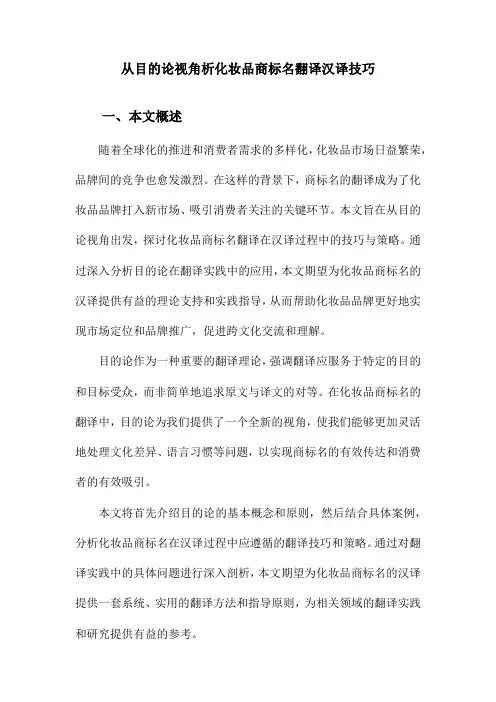
从目的论视角析化妆品商标名翻译汉译技巧一、本文概述随着全球化的推进和消费者需求的多样化,化妆品市场日益繁荣,品牌间的竞争也愈发激烈。
在这样的背景下,商标名的翻译成为了化妆品品牌打入新市场、吸引消费者关注的关键环节。
本文旨在从目的论视角出发,探讨化妆品商标名翻译在汉译过程中的技巧与策略。
通过深入分析目的论在翻译实践中的应用,本文期望为化妆品商标名的汉译提供有益的理论支持和实践指导,从而帮助化妆品品牌更好地实现市场定位和品牌推广,促进跨文化交流和理解。
目的论作为一种重要的翻译理论,强调翻译应服务于特定的目的和目标受众,而非简单地追求原文与译文的对等。
在化妆品商标名的翻译中,目的论为我们提供了一个全新的视角,使我们能够更加灵活地处理文化差异、语言习惯等问题,以实现商标名的有效传达和消费者的有效吸引。
本文将首先介绍目的论的基本概念和原则,然后结合具体案例,分析化妆品商标名在汉译过程中应遵循的翻译技巧和策略。
通过对翻译实践中的具体问题进行深入剖析,本文期望为化妆品商标名的汉译提供一套系统、实用的翻译方法和指导原则,为相关领域的翻译实践和研究提供有益的参考。
二、目的论概述目的论(Skopostheorie)是德国功能主义翻译理论的核心概念,由汉斯·弗米尔(Hans J. Vermeer)和凯瑟琳娜·莱斯(Katharina Reiss)等学者于20世纪70年代提出。
目的论强调翻译行为的目的性,即翻译活动应以实现译文在目标语言文化环境中的预期功能或目的为首要原则。
这一理论突破了传统等值翻译理论的束缚,认为翻译不仅仅是语言层面的转换,更是一种跨文化、跨语言的交际行为。
在目的论框架下,翻译的过程被视为一种有目的的、结果导向的行为。
译者需要根据译文的预期功能或目的,灵活选择翻译策略和方法,以实现最佳的交际效果。
因此,目的论强调译者的主体性和创造性,允许译者在翻译过程中进行适当的调整和创新。
对于化妆品商标名的翻译而言,目的论提供了一个全新的视角。
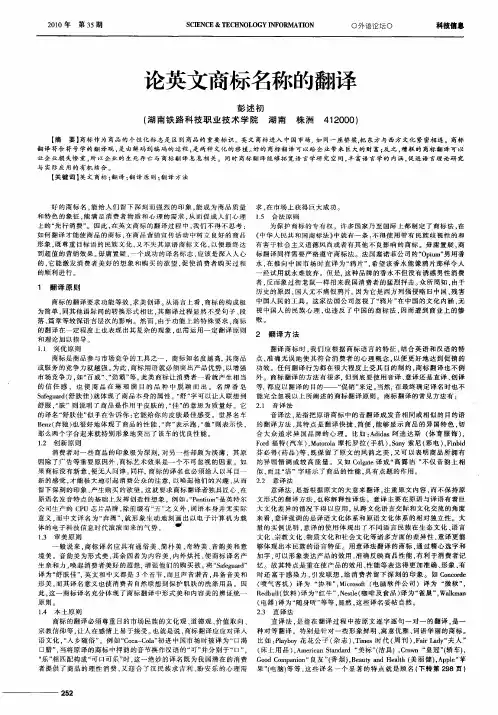
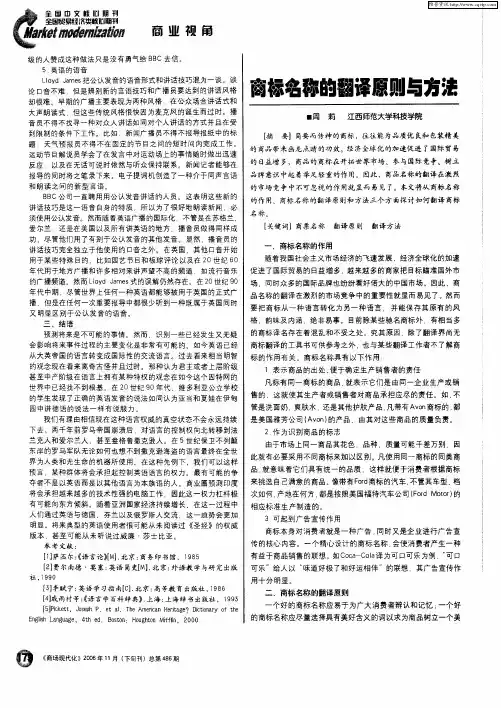
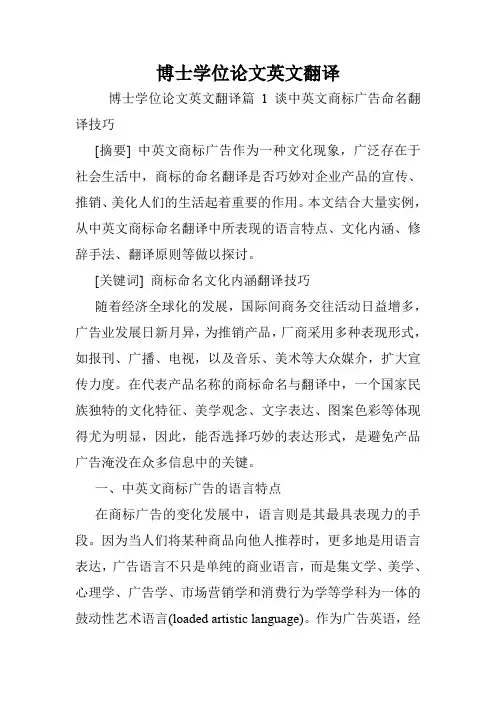
博士学位论文英文翻译博士学位论文英文翻译篇1谈中英文商标广告命名翻译技巧[摘要] 中英文商标广告作为一种文化现象,广泛存在于社会生活中,商标的命名翻译是否巧妙对企业产品的宣传、推销、美化人们的生活起着重要的作用。
本文结合大量实例,从中英文商标命名翻译中所表现的语言特点、文化内涵、修辞手法、翻译原则等做以探讨。
[关键词] 商标命名文化内涵翻译技巧随着经济全球化的发展,国际间商务交往活动日益增多,广告业发展日新月异,为推销产品,厂商采用多种表现形式,如报刊、广播、电视,以及音乐、美术等大众媒介,扩大宣传力度。
在代表产品名称的商标命名与翻译中,一个国家民族独特的文化特征、美学观念、文字表达、图案色彩等体现得尤为明显,因此,能否选择巧妙的表达形式,是避免产品广告淹没在众多信息中的关键。
一、中英文商标广告的语言特点在商标广告的变化发展中,语言则是其最具表现力的手段。
因为当人们将某种商品向他人推荐时,更多地是用语言表达,广告语言不只是单纯的商业语言,而是集文学、美学、心理学、广告学、市场营销学和消费行为学等学科为一体的鼓动性艺术语言(loaded artistic language)。
作为广告英语,经过长期的发展,已逐步从英语家族中脱颖而出,形成了独特的修辞手段,在遣词造句上标新立异,文字简洁,措辞独特。
在语法上打破条条框框,力求达到注意价值和记忆价值的目的。
与一般言语行为相比,广告语最大的特点是具有更突出的劝导倾向,更鲜明的鼓动意图――推销产品。
广告英语作为一种应用语言,因其所具有的特殊效用,已逐渐从普通英语中独立出来而发展成非规范化的专用语言,并具有如下特点:1.趋向具体化即把商品名与某一具体的人、物、概念结合起来。
接受者能通过广告设计的画面或形象,接受具体清晰的信息,例如,大宝DABAO,小护士Mini-nurse,娃哈哈WAHAHA,健力宝JIANLIBAO,康威KANGWEI,宝马BMW等。
2.趋向抽象化即模糊商品的概念,使接受者在给定的意境中,充分调动视觉,听觉,味觉,甚至嗅觉器官,展开联想,从而达到接受信息的目的。

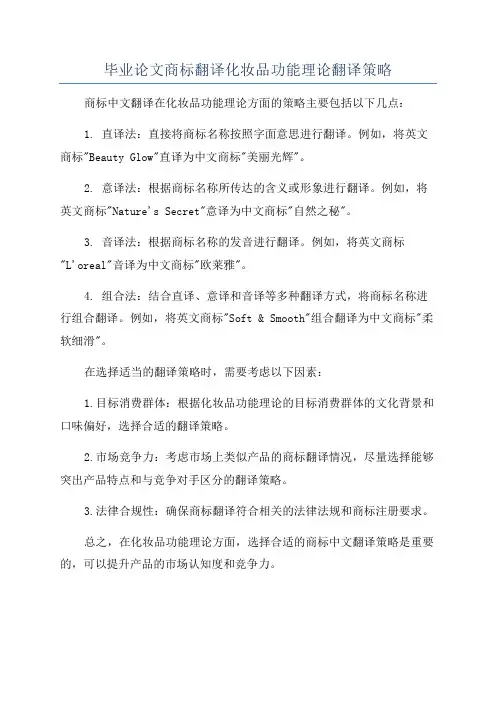
毕业论文商标翻译化妆品功能理论翻译策略商标中文翻译在化妆品功能理论方面的策略主要包括以下几点:
1. 直译法:直接将商标名称按照字面意思进行翻译。
例如,将英文商标"Beauty Glow"直译为中文商标"美丽光辉"。
2. 意译法:根据商标名称所传达的含义或形象进行翻译。
例如,将英文商标"Nature's Secret"意译为中文商标"自然之秘"。
3. 音译法:根据商标名称的发音进行翻译。
例如,将英文商标
"L'oreal"音译为中文商标"欧莱雅"。
4. 组合法:结合直译、意译和音译等多种翻译方式,将商标名称进行组合翻译。
例如,将英文商标"Soft & Smooth"组合翻译为中文商标"柔软细滑"。
在选择适当的翻译策略时,需要考虑以下因素:
1.目标消费群体:根据化妆品功能理论的目标消费群体的文化背景和口味偏好,选择合适的翻译策略。
2.市场竞争力:考虑市场上类似产品的商标翻译情况,尽量选择能够突出产品特点和与竞争对手区分的翻译策略。
3.法律合规性:确保商标翻译符合相关的法律法规和商标注册要求。
总之,在化妆品功能理论方面,选择合适的商标中文翻译策略是重要的,可以提升产品的市场认知度和竞争力。
英文商标名称的翻译与策略 1.前言 2.英文商标翻译的策略 2.1.音译 商标翻译过程中,音译是一种不可忽视的手段,具有极强的普遍性。
音译是指在不背离“汉语语言规范和不引起错误联想或误解的条件下,按照原商标名称的发音,找到与之语音相近的汉语字词进行翻译。
其优点是简单易行,译文有异国情调,可使产品具有一定吸引力。
音译又分为:纯音译﹑谐音译和省音译。
2.1.1. 纯音译 纯音译即根据英文的读音逐字地用相近发音的汉字进行匹配的翻译。
主要适用于专有名词,如:人名商标和地名商标。
这种翻译法是商标在译为中文时,因无法找到相应的汉语表达而不得不采用的翻译方法。
2.1.1.1人名商标 有些商标是姓氏构成的,如:Hoover(胡佛)真空吸尘器,是源于生产商William Henry Hoover的姓氏;Rael-Brook(雷尔-布鲁克)男装,是源于公司创始人H.Rael-Brook的姓氏。
有些商标是人的全名,如:Walt Disney(沃尔特·迪斯尼)制片公司,是根据公司创始人Walt Disney的姓名而定;Pierre Cardin(皮尔·卡丹)时装,是根据该时装的制造者Pierre Cardin的姓名而定;“benz”品牌最早含义是卡尔本茨的姓,根据译音,在中国翻译成“奔驰”。
2.1.1.2地名商标 Santana(桑塔纳)轿车,San Tana原是美国加利福尼亚洲一座山谷的名称;Nokia(诺基亚)手机是根据芬兰北部一座名为Nokia的小镇命名的。
2.1.2谐音译 这种译法是以音为引子,经常是在纯音译的基础上改动个别字眼,这些字眼与原商标读音谐音,改动后的音译商标又结合产品特征。
例如:为纪念航空公司创始人Willian Edward Boeing 人们以其姓氏确定的商标Boeing,译作“博音”,但作为商标,译者改用谐音“波音”,这就可以使人们对这类超音速飞机产生无尽的遐想。
文献综述英语商标名称的翻译与策略一、前言部分(说明写作的目的,介绍有关概念,扼要说明有关主题争论焦点)商标,即商品的“牌子”,是企业宣传和推销产品的利器,也是消费者认识或购买商品的向导,其广告效应已为越来越多的企业所重视。
一个成功的商标有助于产品的推销,而一个成功商标的译名更有利于商品冲出国门,走向世界,从而给企业带来巨大的财富。
尤其随着中国改革开放政策的深入实施以及中国加入WTO,中国企业也面临着前所未有的机遇和挑战。
而在参与激烈的国际市场竞争时,打造知名品牌己成为市场运营战略中塑造企业形象的核心;其中,拥有一个贴切又独特的商品名称及得体的翻译更是国内企业发展的一个非常重要的因素,因此,对汉语商标翻译的研究就显示出其必需性和紧迫感。
商标的定义和特点1.商标的定义我国《商标法》第八条规定,商标是指“任何能够将自然人、法人或者其它组织的商品或者服务与他人的商品或者服务区别开的文字、图形、数字、三维标志和颜色组合、以及上述要素的组合”。
美国营销协会将“商标”定义为:商标是将一个企业的产品或服务与另一企业的产品或服务区别开的标记。
(Kotler, 2000)“技术上讲,当一个商人为一件新产品创造了一个名称、标志或是标识,他/她即是创造了一个商标”(Keller, 2003)。
2.商标的特点从广告学的角度来讲,商标必须新颖独特,令人注目,优美动听,朗朗上口,便于记忆,既要符合商品特征,又要具有象征意义使人产生联想。
因此,商标必须具有以下特点:(1)简洁新颖、便于记忆;(2)内涵丰富、富于联想;(3)符合民族文化。
(袁平, 2001)。
历年来,国内外众多学者从不同的角度对商标翻译进行了广泛而深入的探讨。
其中,著名翻译理论家尤金·奈达(2001)的在其提出的动态翻译理论中认为,要成就高质量的翻译就要让译文的读者不仅仅能准确地获得原文所传达的信息,而且要使译文读者在心理上得到和原语读者相同的感受,更深入地讲即为尊重译文读者习惯的思维模式,在思维模式上实现一种“对等”。
英文商标翻译论文1.英文商标翻译的策略音译商标翻译过程中,音译是一种不可忽视的手段,具有极强的普遍性。
音译是指在不背离“汉语语言规范和不引起错误联想或误解的条件下,按照原商标名称的发音,找到与之语音相近的汉语字词进行翻译。
其优点是简单易行,译文有异国情调,可使产品具有一定吸引力。
音译又分为:纯音译﹑谐音译和省音译。
纯音译纯音译即根据英文的读音逐字地用相近发音的汉字进行匹配的翻译。
主要适用于专有名词,如:人名商标和地名商标。
这种翻译法是商标在译为中文时,因无法找到相应的汉语表达而不得不采用的翻译方法。
人名商标有些商标是姓氏构成的,如:Hoover(胡佛)真空吸尘器,是源于生产商WilliamHenryHoover的姓氏;Rael-Brook(雷尔-布鲁克)男装,是源于公司创始人的姓氏。
有些商标是人的全名,如:WaltDisney(沃尔特·迪斯尼)制片公司,是根据公司创始人WaltDisney的姓名而定;PierreCardin(皮尔·卡丹)时装,是根据该时装的制造者PierreCardin的姓名而定;“benz”品牌最早含义是卡尔本茨的姓,根据译音,在中国翻译成“奔驰”。
地名商标Santana(桑塔纳)轿车,SanTana原是美国加利福尼亚洲一座山谷的名称;Nokia(诺基亚)手机是根据芬兰北部一座名为Nokia的小镇命名的。
谐音译这种译法是以音为引子,经常是在纯音译的基础上改动个别字眼,这些字眼与原商标读音谐音,改动后的音译商标又结合产品特征。
例如:为纪念航空公司创始人WillianEdwardBoeing人们以其姓氏确定的商标Boeing,译作“博音”,但作为商标,译者改用谐音“波音”,这就可以使人们对这类超音速飞机产生无尽的遐想。
省音译省音译是根据中国人的审美习惯,双音节和三音节的商标更能令人过目不忘,有些英文商标单词较长音节较多,如果逐字翻译,读起来拗口且不便记忆,可采用省音译来简化。
商标名称与翻译1.引言这是一个商品经济的时代,随着世界经济的蓬勃发展,品牌已渐趋全球化,消费者的品牌意识也愈发强烈。
“品牌”,也就是商标,是区别不同生产者的标记。
这种标记通常由文字或图形单独构成或组合而成。
而商标词又是商标的重要组成部分,它具有特定的标志意义和丰富的象征意义,承载着独特的商品信息和文化信息,对于提高商品知名度和开拓市场功不可没。
因此,商标在广告营销策略中已显得尤为重要。
而其翻译,即在不同语言间进行恰当的转换也绝非易事。
本文将从现有商标翻译存在的问题出发,分析成因并根据商标翻译的方法和技巧总结商标翻译基本原则。
2.商标的涵义及作用2.1商标的涵义商标是指刻在或印在一种商品的表面或包装上的标志、记号(图画、图案形文字等),使这种商品和其他的同类商品有所区别。
那么商标究竟应该译为brand还是trademark呢?首先,brand是商业术语。
市场营销学最高学术权威机构美国市场营销学会对brand和trademark分别定义为:Brand is a name,term,sign,symbol,design or some combinationused to identify the products of one firm and to differentiate th-em from competitive offerings. A trademark is a brand that hasbeen given legal protection and has been granted solely to itsowner.(王才英,2006:130)定义指出brand是个名词、术语、符号、图案、设计或这些因素的组合,其作用是区别卖者的产品。
而trademark是受法律保护的brand。
它使它的所有者对其具有专有权。
后者是在前者的基础上发展而来的。
2.2商标名称具有以下作用:2.2.1表示商品出处,便于确定生产销售者责任;标有同一商标的商品,就表示它们是由同一企业生产或销售的,这使得其生产或销售者必须承担应尽的责任。
(20 届)英语商标名称的翻译与策略On Brand Name Translation Studies and its TranslationStrategies全球经济一体化的今天,行业间的商业竞争日趋激烈,在这样的环境下,商标之于产品和企业的作用就更不可忽略。
产品的商标恰如人的名字,赏心悦目的商标名让人过目难忘,能够促进产品的销售,而不恰当的商标名将给产品甚至其企业带来厄运。
随着国际经济的发展,越来越多的企业走出国门进军世界市场。
为了成功地让产品在国际市场上夺得一席之地,好的译名商标必不可少。
鉴于此,本文结合商标的特点以及中英语言文化等方面的差异提出了适用于商标翻译的策略:音译、直译、音译直译和意译策略,同时结合大量品牌翻译实例加以论证。
相信木研究对于商标译员和企业都将起到一定的指导性作用。
关键词:商标;中英语言文化;商标翻译策略AbstractAs one of the best strategies of marketing,brand name is of vital importance in the keen competition of businesses in the global economy. Brand name to product is like name to people.A good brand name contributes to the good reputation of a company and can help to propel sales of products while a poor brand name could be disastrous to a company. With the fast development of the international economy, more and more companies are cultivating their markets outside their own nations. To successfully promote products in the global market,a good translation of the brand name is of utmost importance.Based on the characteristics of brand names and linguistic and cultural differences between Chinese and English, the thesis puts forward brand name translation strategies: transliteration, literal translation, combination of transliteration and literal translation and liberal or free translation,which is illustrated with numerous concrete examples. It is hoped that the present study can play facilitating roles for brand name translators and enterprises as well.Key words: brand name; linguistic and cultural differences; brand name translation strategiesContents蚊■ (i)Abstract ........................................................................................................................ I I Introduction . (1)Research Background (1)Research Purposes and Significance (1)Literature Review (2)Definitions of BrandNames (2)Characteristics of Brand Names (2)The Studies on Brand Names Translation Home and Abroad (5)Studies on Brand Names from the Economic Perspective (5)Studies on Brand Name Translation from Cultural Perspective (6)Studies on Brand Name Translation from Linguistic Perspective (7)Brand Name Translation Strategies (10)Introduction (10)Transliteration (10)Literal Translation (11)3.4. Combination of Transliteration and Literal Translation (12)3.5 Liberal or Free Translation (13)Conclusion (17)Bibliography (18)1Introduction1.1Research BackgroundIn a world of rapid economic development, commercial exchange takes an even more important role than before. China, in such a developing condition is strengthening its communication with the outside world in terms of commercials. On the one hand, China,together with all the top brands it boasts is going global, on the other hand,the rest of the world is stepping into China,looking for chances to introduce and sell their top brands in the large potential market. A popular brand name is a must for the products promotion work, and it is also of vital importance to make sure that a good brand name maintains as a popular one when it is introduced to a new market. And this is the arduous task that a translator shoulders.However, in real life, we often encounter numerous lousy translations of brand names. A case in point is Chinese product 较身减月巴片,which is rendered into Obesity Reducing Tablets. When such product was exported to America,for a long period, the tablet was a slow seller. Through market research, it shows that brand name did not meet the people‟s psychological demand because this product was regarded as the medicine for obese people. Based on the above considerations, the author carries out a study on the brand name translation and its strategies,and hopefully the proposed strategies can shed light on brand name translation and guide translators in the translation practice.1.2Research Purposes and SignificanceTranslation is defined as “a complex action designed to achieve a particular purpose” (Newmark,2001: 6). When it comes to brand name translation, the ultimate purpose is to make target consumers know the products and further invite them to buy the products.According to this special purpose of brand name translation,we find it is necessary and significant that appropriate translation strategies of brand name must be develop to cope with this important branch of practical translation—brand name translation. Thus,this thesis makes an in-depth analysis of brand name translation and appropriate translation strategies.The purpose of the study is twofold. First, to arouse general awareness that brand name translation is significantly essential especially in the age of the globalization. Second, to put forward translation strategies which are highly amenable to the translation of brand names.2Literature Review2.1Definitions of Brand NamesThis thesis focuses on brand name translation,so it is important for us to have an overall understanding of what brand name is.“Branding makes a product distinctive in the marketplace,just as your name makes youunique in the society in which you live.”(Wells,Burnett and Moriarty, 1999: 89)It is “a name given by a producer to a particular product,by which it may be recognized from among alike products made by other producers.” (Longman Contemporary English-Chinese Dictionary English, 1988)“A trademark is any word,name, phrase,symbol,sign, design,or packaging that is distinctive and that identifies and distinguishes the source of a particular product. A trademark typically appears on the product or on its packaging•”((Lubliner,1993:16)Actually, people are confused in its conception even in Europe and America where commerce developed. A successful brand is defined,by Chernatony and McDonald (1994),as “an identifiable product,service, person or place, augmented in such a way that the buyer or user perceives relevant unique added values which match their needs most closely”. In the British, consumers have been shown, by de Chernatony and McWilliam (1989),to hold typically one of four complementary and overlapping views of brands:1 • A visual identifier.2.A guarantee of consistent quality.3.A shorthand device.4.An expression of self-concept. (Chernatony and Me William, 1989: 29-32)The above-mentioned definitions prove the brand is a concept of compounding, it is formed by the brand outside mark (including name, term, pattern etc.),brand discerning, brand legend brand image,etc. While in this thesis, brand names mainly refer to the part of a brand that can be expressed in words.2.2Characteristics of Brand NamesAiming to build, reinforce, and reposition consumers‟ perceptions and understandings of a certain brand, brand names have the following four functions, that is, distinguishing products, providing information, ensuring guarantee and stimulating consumption desires.In order to build a positive image in the market and arouse favorable associations as well as purchasing desires in the mind of consumers, brand names are required to have the following major characteristics: brevity, sonority and memorability,significance,elegance and appropriateness,originality and novelty.Because of the peculiarity of the brand name that it carries the main and final purpose of achieving sales,the first and foremost characteristics of brand names are brevity,sonority and memorability. Only those brief,easy-to-understand and memorable brand names will win the approval of consumers.For example,Uha (悠哈),a candy brand name, is short and sweet. In pronouncing Uha,lovely,cute, adorabe feelings emerge in people‟s mind, which appeal to its target consumers. Apart from that,the translated brand name keeps the syllabus of the original name. ‚雅客’’(Yake),in the same way,the pronunciation is crispy,sonorous and agile. The Chinese version also gives us elegant and cultivated feelings. What‟s more,‚雅客‛ is the alternative name of the flower Narcissus. From above examples,the characteristics of brevity, sonority and memorability make brand names impressive,which are helpful to reach the purpose of sales of products.In most cases,brand names have rich meanings and associations. Apart from being brief,sonorous and memorable, another important characteristic of brand names is significance, in other words, brand names usually carry rich connotations. A case in point is the brand name ‚彩虹’’ (Irico),whose English version is composed of “Irix” and “Corporation”. Irix is a Goddess in Greek Mythology whose responsibility is to spread good news. This happens to be in li ne with this Group‟s purpose: to be the creator of a sweet life for human beings. If it was literally translated it into rainbow, the effect would be discounted.Goodyear, a tire brand name, means an auspicious and harvest year; the translated version ‚固特异‛ not only is similar to Goodyear in pronunciation but shows attributes of the product of being solid,special and unique.‚丙冷,’ (Serene) is an air-conditioning brand name. The meaning of “丙冷‟‟,in Chinese people‟s mind,is cold and dry; for the translated version Serene,though it contains more meanings as being clam, quiet and composed,the original meaning of coldness is reduced.Elegance and appropriateness refer to the meanings of brand names or the ideas they conveyed. Since the purpose of brand names is to be recognized and accepted by consumers,the information transferred by the brand name is required to be correct and appropriate, that is, in accordance with characteristics of the commodity. For instance:Band-aid----- 邦迪(bandage for first aid)Goldlion——金利来(shirt)Marlboro ---- 万宝路(cigarette)Giant ---- 捷安特(bicycle)Paloma ----- 白乐满(gas-burning appliance)Contac-----康泰克(cold medicine)天翼--- E-su对ing (net sdevice)‚天翼’’(E-surfing),a new brand released by China Telecom to fulfill the mass customers‟ need for information services. ‚天翼‛ means flying freely in the sky;accordingly,“e-surfing” means surfing the web to one‟s heart's content. With e-surfing, cell phones or laptops are like having wings flying freely in the online world. The translated brand name well transfers the meaning of the original brand name and thus can be regarded as an elegant and appropriate translated brand name.Giant is the brand name of a bicycle,whose original meanings are huge,great,or people of vision; the translated version furthers the original meanings and shows that the product is swift, safe and special. Besides, the pronunciation of ‚捷安特‛ is similar to the original brand name Giant. So, ‚捷安特‛ embodies the characteristics and meanings of the original brand name.To be unique and distinctive in the market,brand names of products are required to be original, novel and creative. The first impression of the brand name left in consumers‟ minds is very important and it constitutes a reason for the product to be selected among numerous products of the same type. So, a successful brand name and its translation are required to be instantly recognizable. Therefore, an excellent brand name holds attributes of novelty,attractiveness and originality.Take the wall clock brand EMIT as an example. The brand EMIT is said to be novel and original because it is the back-to-front spelling of the word “TIME”,meaning breaking through the traditions. What‟s more, EMIT is rendered into ‚情有独钟‟‟,in which, ‚钟’’ is endowed with the meanings of both the clock (referring to EMIT) and its original meaning in the set phrase. Both EMIT and ‚情有独钟’’ are interesting and impressive and can be said to be original and novel.The Chinese version of B.CHOW—‘‘比倘’’ is also an outstanding example because it vividly describes the mood of “want to be more charming and pretty than others”. This thought makes the brand name distinctive and impressive.The candy brand Fujiya is rendered into ‚不二家‛ which is interesting and fresh in the market. The Chinese version shows uniqueness,originality and individuality of the product.2.3The Studies on Brand Names Translation Home and AbroadVarious researchers have endeavored to study brand names. The previous studies on brand names can be categorized into three groups: 1) economic perspective; 2) cultural perspective; and 3) linguistic perspective.2.3.1Studies on Brand Names from the Economic PerspectiveBrand name is a product of economic development, so economic and market research on it plays an important role in our society. Based on the research findings, what the experts study mostly are how to create,design,market,develop,and manage brands. Aaker (a businessprofessor at University of California at Berkeley) and Kevin Keller are two American branding experts, who make theoretical and scientific analyses on brand names in their works. They contribute a lot to the research in this field. Aaker (1991) brilliantly examines how to create, market,develop, and manage brands strategically in the 1990s.Keller (1998) provides a comprehensive treatment of the subject of brands,brand equity,and strategic brand management, concerning the design and implementation of marketing programs and activities to build. John Murphy,a branding expert in Interbrand (global branding consultancy),has edited and published many guidebooks on brands. In addition,most researches on naming primarily focus on characteristics and functions of English names. For example,Peterson & Ross (1972) find that it is important to select names that build on familiar words,because consumers may already have positive notions about such words. Other researches demonstrate that the favorability of a brand name is used as a heuristic cue when consumers make product judgments (Maheswaran,Mackie & Chaiken,1992). The brand‟s role in the field of marketing has changed dramatically during the past decade. In the past, we used to name already existing products or companies in order to make them more attractive to consumers. In contrast recently, developing a brand means devising and implementing a way by which to deliver a benefit to consumers. Such concepts direct the development of products and services designed to supply the benefit,and even shape entire organizations for this purpose. Trade Mark English,ritten by He Chuansheng (1997),illustrates the motivation of brand formation from the perspectives of psychology,marketing,sociology and culture,meanwhile,he analyzes the effects of brand used as verbs and adjectives in modern English. His article, New Industry Survey of American Language report: brand name,is a survey of a flourishing language industry in the US (贺川生,2003). Psychology is closely related to brand naming when we want to create a successful brand. Hou Ruilong (1997: 260) explores the psychological strategies of brand naming and indicates what a trap is when strategies of single brand name are used.2.3.2Studies on Brand Name Translation from Cultural PerspectiveAnalysis on brand names translation covers the majority of language research of this field in China. Zhu Fan (2002) makes a comment on brand names translation in her article, a most representative study based on more than 120 articles from 1994-2001. According to the principles and features of brand names, Guo Shangxing (1995) divides brand names into five categories and indicates problems of brand name translation in China. Chen Quanming (1996) introduces four methods for English-Chinese import brand name translation. Peng Shiyu (2001)proposes four methods for C-E brand name translation: homophonic translation,literal translation, direct translation and blending translation,in which blending translation is the best way to internationalize Chinese brand names. Bao Huinan (2001) analyzes principles of translation from Chinese brand name to English from the perspective of language and culture. She considers most Chinese brand names are in the form of Chinese characters or Pinyin, so the products with such brand names are sold well in domestic market but not in foreign market. Teng Yanjiang(2004) attempts to point out the phenomenon of cultural aphasia in C-E trademark translation and shows the way of dealing with such problems in C-E trademark translation and how to avoid such mistakes in practice.Verbification of brand names originates in 1940s,which is a fresh language phenomenon. In China, translation on verbification of brand names is from Zhang Dinxing(1997) who makes a preliminary study on its word source, history background, meaning and translation. He also stresses that “verbification of vehicle‟s brand names is a new trend in modern English vocabular y and verbification of automobile brand names is the most popular”(张定兴,1998). The article is limited in describing brand names examples,which is a conclusion of rules or language features on verbification. So Zhang Dinxing (1999) studies it from the view of stylistics and pragmatics on the basis of his further research on English brand names. He considers, in order to translate verbification of brand names very well,translators must constantly learn new knowledge and read foreign newspapers and journals as much as possible.Ever since brands come into being, they are blessed with cultural meaning and closely connected with culture. Ethical cultural meaning is contained in a small brand name, in which lexical meaning is added with emotion,cultural symbol or cultural association.Brand names can express their special meanings and be understood only under the specific cultural background. Companies pay attention to both the form of brand and its culture, so there are many cultural studies on brand names.Cao Zhiyun (1992: 165) analyzes the culture phenomena of Chinese brand naming, and illustrates the characteristics of brand language such as distinction, art and social function. Peng Shiyu (2001) holds that the design of Chinese brand and brand names should not only absorb other culture‟s virtue but also work out how they will be accepted easily,which makes Chinese brand and brand names international Zhang Xiangyang(2005) probes the cultural implication and object of automobile brand names. Because of different cultures,English and Chinese brand names are different from each other. Geuens & Pelsmacker (1999) make a comparison between brand naming in English and Chinese, “there are some common points in naming brand names in English and brand names in Chinese. Brand names are relatively short, so generallyspeaking,such devices as symbolism and association are used in naming so as to convey the information about the products as much as possible. But there are some obvious differences in the brand names in English and the brand names in Chinese because of the differences between the cultural psychology,the linguistic characteristics and the way of thinking.” Hu Kaibao (1999) conducts a research on some differences between English and Chinese brand names from the perspectives of the sources of brand names, syllables, relations between quality of product and its brand name.233 Studies on Brand Name Translation from Linguistic Perspective Scholars in US attach much importance to linguistic research on brand names. The most famous representative is Vanden (1987) who analyzes language features of 200 brand names from 1971 to 1985 in US. Aronoff (1981) published his Automobile Semantics in the journal Linguistic Inquiry. Ingrid Filler‟s PhD dissertation American Automobile Names (1996) can be reckoned as one of the best literatures on brand naming available at present. By studying the place names of automobile in general language, she thoroughly investigates the nature of American automobile names which are collected from a corpus of more than 2000 such names. Robertson, K. (1987),a psychologist,puts efforts into the study of proper names, including brand names and published Dictionary of Trade Name Origins, which collects quite a lot of famous brand names.In China,the study of brand names can be traced back to Zhuang Hecheng (1988) and Sun Dequan (1988) who are the first Chinese scholars in this field studying simple features of brand names and problems of translation. Zhu Yajun(2003) studies brand names from the perspective of some branches of linguistics,which include phonetics, grammar,semantics,pragmatics,semiotics,translation, and indicates relevant factors of brand naming. He takes the functional equivalence theory to describe brand name translation and provides three principles: accordant,relevant, brief,and three translation methods: equivalent method,complementary method and homophonic method. It has mentioned that a brand name with favorable (positive) associations to consumer psychology will contribute to the success of this brand.The literatures about lexical analysis for brand name are limited. Liang Guotao (1992) divides trademarks into three categories: name trademark words, such as Cadillac.,word trademark words, such as Apple; arbitrary trademark words, in which word-formation is applied, such as Kodak.Liang Guotao(1998) adds the fourth category of brand names—shortening trademark word, such as IBM and says brand names are different from common words, because they are industry property right. Hou Ruilong(1997: 260) explores the psychological strategiesof brand naming, and figured there is a trap of brand naming in using the strategy of single brand name, which would lead to failure of enterprises. Wu Hanjiang & Cao Wei(2005) introduces brand names,words, letters and numbers in brands, gives classification of Chinese brands, analyzes phonetic,lexical and syntactic features of brand language. As brand names cannot be arbitrarily created, Zhu Wangzhong & Su Gailian (2006) briefly analyze the motivation of pronunciation, word-formation and meaning of coined English brand names and gives some cases of brand names of export product.The previous literature shows us a lot of successful achievements on the research of brand names,yet there are still some problems left. Many linguists focus their research on proper names but pay little attention to brand names. According to the previous literature which is mostly about economics, translation,culture and linguistics, we can find the previous studies do not elaborate on the translation strategies that are appropriate to translation of brand names. Under this backdrop,the present study conduct research in this field with the hope of arousing the public‟s awareness of brand name translation and at the same time, offering app ropriate translation strategies that can render a well-translated brand name.3Brand Name Translation Strategies3.1IntroductionThe translation of brand names is not a simple transfer from one language to another; instead,it is a recreation process. The same brand name may have different translations to stand for different types of products. For example, the baby‟s daily use cosmetic Johnson & Johnson is translated into 虽生”,while an enterprise named as Johnson is translated into ‚庄臣As an underwear brand name, Triumph is rendered into ‚黛安芬”,but as a car brand name, it is translated into ‚凯旋As a chocolate brand name, Dove is translated into ‚德芙‟‟, while as a body wash,it is rendered into‚多芬Apart from this,Dove can also be translated into ‚多福’’ or ‚得福‟‟,which are meaningful and fortunate in Chinese people‟s eyes.Different from common language translations, brand name translations consider more on the nonlinguistic factors,such as products and consumers, esp. cultural factors infiltrated in language. Some translation strategies for the translation of brand names are listed as follows.3.2TransliterationIn translating English brand names, transliteration is a strategy that cannot be ignored. The advantage of this strategy is that it is easy and feasible; meanwhile,the strategy of transliteration endows translated brand names with exotic tints and feelings. This strategy is widely used in the translation of brand names because it not only keeps the consistency of product images globally,but also remains the rhythmic beauty and sonorous beauty of original brand names. For example:Motorola ----- •摩托罗拉(cell phone)Swatch ---- 斯沃琪(观tches)Pocky-----百奇(decorating biscuit)Subway----- 赛白味(fast food)Eucerin ----- 优色林(cosmetic)Reebok ---- 锐步(shoe)Sharp ----- 夏徵electronic home appliance)Kelon ----- 科龙(electronic home appliance)Galanz ---- 格兰仕(electronic home appliance)Ericsso ---- 爱立信(cell phone)Virjoy ——唯洁雅(tissue)Nepia -----妮飘(tissue)In the translation of Pocky and Subway, the translated brand names ‚ 白奇‛ and ‚赛白味‛ not only are similar to the original pronunciations,but expend the meanings of the original names. Pocky shows a magical pocket that produces various wonders,which is in accordance with Chinese people‟s psychology of being fond of surprises and expectations; while Subway mean to show that their service speed is faster even than a subway and their food taste better than any others.To sum up, the transliteration strategy emphasizes phonological forms of brand names, going after phonological similarities between brand names in the source language and the target language. It tries to find out the same or similar words or morphemes to the original brand names. This strategy confines translators to the phonological forms of brand names in source languages but gives translators wide flexibilities in conferring meanings to translated brand names.3.3Literal TranslationLiteral translation means to translate brand names directly on the basis of its literal meanings. This strategy is adopted when the translated brand names have the same cultural images as in the source language. As the major strategy for the translation of brand names,the literal translation strategy maintains characteristics of original brand names and conveys accurate original information and feelings directly and precisely. For example: Tiger ----- 虎(beer)Crown ---- 皇冠(automobile)Playboy ----- 花花子(clothing)Cover girl --- 封面女郎(cosmetic)Fair Lady ---- 贵夫人(cosmetic、Good Companion ----- 良友(cigarette)Naughty Monkey ---- 顽皮猴(clothing)Blue Ribbon ---- 蓝带(beer)May flower--- :五花(tissue)营养快线--- Nutri-express( beverage)Among these examples, the original brand name Tiger gives people the feelings of bravery and fierceness,which are liked by most male consumers. The literally translated brand name ‚虎‛ well conveys the information of the source language; at the same time, it attracts the attention of target consumers. Thus the brand names in both the source language and the targetlanguage well perform the function of promotion.Blue Ribbon is rendered into ‚蓝带Blue Ribbon,in English,has connotations of masterpiece, the highest honor,top-ranking,etc.; however,these meanings are not loaded on the correspondingly translated brand name ‚蓝带”,which just means ribbons of the blue color. The same situation happens to transliteration in some cases. Thus there are some limitations for both the transliteration and the literal translation strategies.3.4. Combination of Transliteration and Literal TranslationThe strategy of the combination of transliteration and literal translation makes translated version of brand names close to the original brand names both in meanings and in pronunciations. For example:沧沧--- C hacheer (melon seeds)回力--- W arrior( shoe)Xtep ---- 特步(shoe)Seven up ----- 匕喜(bevercige)Pampers ------帮宝适(diaper)Polaroid ---- 拍立得(camera)Hygienix ----- 洁云(tissue)Kleene ----- 舍了,洁(tissue)Signal ---- 洁诺(toothpaste)Colgate ---- 高露'洁(toothpaste、Walex ---- 威洁丄.(washing powder)HiSense ---- 海信{TN set)Povos ---- 奔職electrical home appliance)相宜木亨-- Si noway Herb (cosmetic)The translated version of …‘洽洽’’ (Chacheer) combines the pronunciation of ‘‘洽’’ and its meaning of being happy or cheerful. The sneaker brand name “[H|力‛ is translated into Warrior,which is similar not only to ‚回力’’ in pronunciation, but also in meaning. Semantically, ‚回力‛ means tremendous power to overcome difficulties,corresponding with the meaning of the word “Warrior”. So it is thought that people who wear the Warrior sneaker would be like a warrior who had tremendous powers.‚相3T•木草‟‟,literally means to maintain skins with herbs; its translated version Sin 側ay Herb, means the Chinese way of protecting skins with herbs. The translated version helps foreign customers to know more about the product.。
浙江长征职业技术学院毕业设计(论文)论文题目:商标名称的翻译和策略系别:应用语言系专业班级: 09 商务英语3班学生姓名:孙城指导教师:柴畅二○一二年四月二十三日目录摘要 (1)引言...................................................................................................................................错误!未定义书签。
1商标名称的特点..........................................................................................................错误!未定义书签。
1.1商标名称的语言特征 (2)1.2 商标名称的其他特征 (3)2商标名称的构成 (3)3商标名称的翻译策略 (4)4 商标名称的翻译方法 (4)4.1 音译 (5)4.2 直译 (5)4.3 调整 (5)4.4音译+意译 (5)4.5 音译+直译 (5)结语 (6)参考文献 (7)致谢 (8)商标名称的翻译和策略【摘要】商标是一种特殊的语言符号,是商品显著特征的浓缩,是商品文化的重要部分,是企业参与国际竞争的有力武器。
它既是标识,又是诱饵,最终是要招揽顾客,出售商品,更是一种策略。
好的商标翻译可以给企业带来巨大的财富;反之,糟糕的商标翻译可以让企业损失惨重,所以企业的生死存亡与商标翻译息息相关。
本文主要探讨商标名称的翻译及其策略。
【关键词】商标名称翻译策略Abstract:Trade mark is a special language symbol. It is the concentration of the notable feature of commodity and an important part of the culture of commodity. It is also a powerful weapon for the enterprise to involve in the international competition. It is a strategy to attract customer and promote sales. A good trade mark may bring great wealth to the company, while a bad trade mark may lead to heavy losses. The translation of trade mark is of vital importance and closely related to a company. The translating skills and strategy are analyzed in this paper.Key words: brand name translate strategy引言商标是刻在或印在一种商品的表面或包装上的标志、记号(图画、图形、文字等),使这种商品和同类的其他商品有所区别。
商品的商标如同人的名字,是产品形象的代表和产品质量的象征。
好的商标能带给人美的享受,激发消费者购买欲望,为商家带来巨大的经济收益。
商标是语言文字和民族文化的统一体,具有典型的文化属性,承载着一定的文化涵义,故其翻译必然进入跨文化交际的领域,成为跨文化交际的一面镜子。
1 商标名称的特点1.1 商标名称的语言特征商标名称无论是汉语还是英语, 都具有读音、形体和意义上的美感,我们可称之为商标名称的“三美”。
这正是设计、选定、衡量乃至翻译商标名称的一个准绳。
汉语商标名称具有以下特征:第一、读音上响亮动听、朗朗上口、节奏感强。
第二、拼写上引人注目、易懂易记、方便传播。
第三、意义上吉利、祥和、美好、富于想象。
英文商标名称具有以下特征:第一、In terms of sound; easy to pronounce, pleasant to ear, sonorous(发音顺口悦耳)。
第二、In terms of form: eye-catching, brief, terse, easy to remember(形式惹人注意、简明扼要、易于记住)。
第三、In terms of meaning: positive, rich in association and collocation, sweet and elegant(意义积极肯定、富于联想、优美雅致)。
由此可见,英汉商标名称具有几乎相同的一般语言特征。
这主要是因为无论哪种语言的商标名称都有许多相同之处。
比如,它们都是为了吸引顾客、促销产品、树立形象、创收利润、具有相同的广告功效和魅力。
这就为商标名称的英译或汉译提供了很好的契机。
1.2商标名称的其他特征大体上看,一个好的商标名称不仅具备简明上口,过目不忘的特点,还具有以下几种特征:一、独特性。
商标名称作为企业形象、产品质量与信誉的标志,它是具有自己独特的个性,一般不会与其他企业商标或产品名称重复或类似,否则不利于商标形象在市场上的传播,不利于消费者识别。
如:“老板”商标贵在新奇、独特,它既迎合时尚,又有较强的识别性,消费者当然记住了。
二、专有性。
所有的商标均须向所在国家的商标管理机构注册,以取得专有权。
商标一经注册,在法律上既归个人或公司独家所有,其专用权不容侵犯,其他任何个人、厂家或公司不得使用同名商标。
这一特征决定了商标名称所具有的特定的文化内涵。
一个好的商标名称会尽可能避免含有对任何国家的冒犯之意。
三、联想性。
商标命名要让消费者易于接受,除了名字本身新奇,独特便于识别外,还会积极启发消费者的正面联想。
丰富、恰当、具有美感的联想是成功商标名称的一大特点。
“柯达”(Kodak)读起来让人联想到照相时按动快门时的声响;“红豆”源于唐朝诗人王维的诗句,则让人联想到纯洁的爱情。
相反,有些商标名称会带来负面的影响。
如: Gold Lion(领带)开始被翻译成“金狮”,与“尽输”读音非常相近。
试想有谁会愿意买它的产品呢。
尔后发明者绞尽脑汁找到解决的办法,将它译为“金利来”。
“金利来”一叫即响,很快为消费者所接受,给企业也带来了好运。
无论是商标名称的命名还是翻译,我们都必须充分考虑到商标名称的特征,最终能够让产品打入市场甚至国际市场,给企业带来巨大效益。
四、商标的命名应有发展战略眼光。
商标的命名不仅要站得高,还要看得远,要有超前意识和发展眼光,要站在世界和国际市场大环境的高度去把握和选定商标的名称,使自己的产品不仅成为某一地区的名牌,更要成为全国名牌,世界名牌。
2 商标名称的构成纵观世界众多的商标,其名称来源甚广,大千世界,万事万物都可作为商标名称的选择对象,但有一定的规律可循。
一般可从以下几个方面进行命名。
一、以企业的名称命名。
这类商标明确了商标同企业的关系,便于消费者了解产品来源,对于一些享有盛誉的老字号企业来说,以这种方式命名的商标突出了企业信誉,增加了消费者的信任。
如:北京同仁堂制药厂的“同仁堂”商标等,都是以企业的名称来命名商标的。
二、以企业的简称或缩写命名。
此种方法命名的商标既在一定程度上体现了企业名称,表明了产品来源,又简短易记,一举两得,是目前采用较多的方法。
三、以古典传统文化来命名。
此种商标名称能引起人们丰富的联想,缩短消费者与企业间的距离,给人以似曾相识和重遇故知的感觉:“济公”食品等是从古典传统文化中找到了好的名称并派上了新的用场。
四、以吉祥褒义词语来命名。
以吉祥褒义词语命名的商标能抓住人们期盼祥和、美好的心愿,产生对商品的好感和认同。
五、以风景名胜来命名。
优美的自然风光和名胜古迹。
以此命名能唤起人们对美景的向往,从而对商品产生好感。
此种方法主要以人们熟悉的自然风光和名胜古迹为题材。
如“长城”牌风雨衣,“长江”牌音响,等等。
六、以动物花卉来命名。
以形象惹人喜爱的动物花卉来命名商标,能使消费者感到熟悉和亲切。
如:“熊猫”牌电视,“小天鹅”牌洗衣机等。
七、以不表意词语来命名。
以不表意词语来命名商标,打破了商标名称表意的传统习惯,减少了与其他商标的重复机会,增加了商标的显著性,商标的适应性更强,应用范围更广。
如美国“KODAK”(柯达)商标,并没有因为名称的不表意而造成不便记忆。
它除了朗朗上口,易发音外,还使消费者联想到照相机快门那令人兴奋的“咔塔”声音。
3商标名称的翻译策略商标名称的翻译必须符合民族语言特点,好的译名可使商品在国际市场上魅力倍增,厂商在商标译名上常是百里挑一。
英汉商标名的翻译首先应符合民族语言特点。
英语注重发音,商标名大多由开口度大的响亮的元音(以长元音和双元音为多)与阻塞程度小、易于拼读的辅音组合而成,并且常用头韵和元音叠韵,使拼读起来抑扬顿挫,易读易记。
如: Kodak—柯达、Buick—别克。
汉语对语义依赖性强,商标名注重意合和神似。
Audi—奥迪、Nokia—诺基亚,这些音译名虽不符合汉语词汇常规的组合模式,但发音清晰响亮,注意平仄及音节长短变化,又无生僻古怪的字眼,因而为消费者所接受。
再如: Camel—骆驼、Zebra—斑马、Nestle—雀巢、App1e—苹果、Pioneer—先锋,这些意译名采用的都是汉语中的普通词汇,简洁朴实,一目了然,易懂易记;且利用汉语复合韵母多的特点,使译名读起来朗朗上口,铿锵悦目,流畅自如。
汉语商标名称倾向于传统和大众化。
中国人喜欢以历史人物名、地名、动物名、花草名、山水名为商品命名。
“竹叶青”(酒)、“翠竹”(窗帘)、“水仙”(风油精),则是人们喜爱的动植物。
通俗是汉语商标名的基本出发点,因为只有这样才能拉近产品和消费者的距离,增强产品的亲和力,从而激起他们的购买欲望。
如:“联想”(电脑)、“金星”(电视)、“黄山”(电视)、“英雄”(钢笔)、“光明”(饮料)、“红旗”(汽车)、“永久”(自行车)、“哥俩好”(粘胶)。
4商标名称的翻译方法商标名称的翻译的目的就是使不懂原语的人通过译文而懂得体现在原文信息中的思想意图,并使原文信息传播得更远。
这也是商标名称翻译所追求的。
多姿多彩的商标名称决定了其翻译技巧也多种多样。
传统的翻译方法音译法、意译法和谐音联想法已无法满足社会发展的需要了。
随着商标名称的增多商标名称的翻译方法也应随之发展和变化。
4.1 音译在商标名称翻译中,直接将原商标名称音译过来。
我国商品中不少是以地名、名胜及具有民族风格的事物来命名,音译可以保留中国特色情调,顺应消费者心理,达到广告劝诱效果。
中国的茅台酒历史悠久,驰名中外。